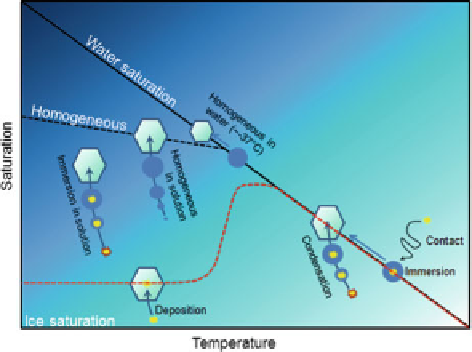Geoscience Reference
In-Depth Information
Fig. 12.4
Pathways of ice
nucleation
The definitions of the various pathways of ice nucleation are not uniform throughout
the literature, but in general we use those of the International Commission on Cloud
Physics (Vali
1985
) which contrast with those of Pruppacher and Klett (
1997
)in
some respects. These pathways are
immersion freezing
that occurs when the IN is
immersed within a supercooled liquid droplet,
contact freezing
through the collision
between an IN and the air-liquid interface of a supercooled droplet,
deposition
nucleation
that occurs via deposition of water vapor directly onto the IN surface,
and
condensation freezing
that involves the condensation of water vapor onto the IN
prior to freezing. In addition to these standard modes of nucleation, an “inside-out”
nucleation process has been identified in which solid particles immersed within a
droplet come into contact with the air-water interface and only then initiate freezing
(Durant and Shaw
2005
;Shawetal.
2005
; Fornea et al.
2009
). It has been proposed
that this may occur while a droplet evaporates (Durant and Shaw
2005
).
At temperatures above about
25
ı
C, where supercooled water commonly exists
in mid- or low-altitude clouds (Kanitz et al.
2011
; Choi et al.
2010
; Morrison
et al.
2012
), ice nucleation tends to only occur at around water saturation (i.e.,
under conditions where liquid water can exist). A number of field studies of ice
formation in mixed-phase clouds show that nucleation below water saturation does
not occur to a significant extent and instead liquid water is a prerequisite for ice
formation (Ansmann et al.
2009
;deBoeretal.
2011
; Field et al.
2012
; Westbrook
and Illingworth
2013
). Contact nucleation is not thought to be significant in deep
convective clouds (Cui et al.
2006
; Phillips et al.
2007
), but may be important in
some situations, particularly where droplets are evaporating (Ansmann et al.
2005
;
Ladino Moreno et al.
2013
). In contrast, immersion freezing is thought to play a
key role in cloud glaciation throughout the development of mixed-phase clouds
generally.
Cirrus- and cirrostratus-type clouds are composed entirely of ice and form in the
upper troposphere below the homogeneous freezing temperature (
37
ı
C). Some
of these clouds form in situ, whereas others are formed from the outflow of deep

Search WWH ::

Custom Search